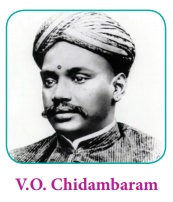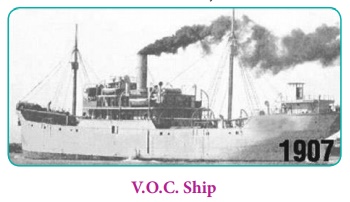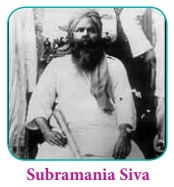V.O.C. and Swadeshi Steam Navigation Company (SSNC)
The Swadeshi movement in Tamil Nadu came to national attention in 1906 when V.O Chidambaram mooted the idea of launching a swadesh shipping venture in in opposition to the monopoly of the British in navigation through the coast.

In 1906, V.O.C. registered a joint stock company called The Swadeshi Steam Navigation Company (SSNC) with a capital of Rs 10 Lakh, divided into 40,000 shares of Rs. 25 each.
Shares were open only to Indians, Ceylonese and other Asian nationals. V.O.C. purchased two steamships, S.S. Gallia and S.S. Lawoe. When in the other parts of India, the response to Swadeshi was limited to symbolic gestures of making candles and bangles, the idea of forging a Swadeshi Steam Navigation Company was really spectacular. V.O.C invoked the rich history of the region and the maritime glory of India’s past and used it as a reference point to galvanize the public opinion in favour of a Swadeshi venture in the sea.
The initiative of V.O.C. was lauded by the national leaders. Lokmanya Tilak wrote about the success of the Swadeshi Navigation Company in his papers Kesari and Mahratta. Aurobindo Ghose also lauded the Swadeshi efforts and helped to promote the sale of shares of the company. The major shareholders included Pandithurai and Haji Fakir Mohamed.

The initial response of the British administration was to ignore the Swadeshi company. As patronage for Swadeshi Company increased, the European officials exhibited blatant bias and racial partiality against the Swadeshi steamship.
(c) The Coral Mill Strike
After attending the session of the Indian National Congress at Surat, V.O.C. on his return decided to work on building a political organisation. While looking for an able orator, he came across Subramania Siva, a swadeshi preacher. From February to March 1907, both the leaders addressed meetings almost on a daily basis at the beach in Tuticorin, educating the people about swadeshi and the boycott campaign. The meetings were attended by thousands of people. These public gatherings were closely monitored by the administration.
In 1908, the abject working and living conditions of the Coral Mill workers attracted the attention of V.O.C and Siva. In the next few days, both the leaders addressed the mill workers. In March 1908, the workers of the Coral Cotton Mills, inspired by the address went on strike. It was one of the earliest organised labour agitations in India.
The strike of the mill workers was fully backed by the nationalist newspapers. The mill owners, however, did not budge and was supported by the government which had decided to suppress the strike. To further increase the pressure on the workers, the leaders were prohibited from holding any meetings in Tuticorin. Finally, the mill owners decided to negotiate with the workers and concede their demands.
This victory of the workers generated excitement among the militants in Bengal and it was hailed by the newspapers in Bengal. For instance, Aurobindo Ghosh’s Bande Matram hailed the strike as “forging a bond between educated class and the masses, which is the first great step towards swaraj…. Every victory of Indian labour is a victory for the nation….”
Arrest and imprisonment of V.O.C. and Subramania Siva
On March 9, 1907, Bipin Chandra Pal was released from prison after serving a six-month jail sentence.The swadeshi leaders in Tamil Nadu planned to celebrate the day of his release as ‘Swarajya Day’ in Tirunelveli. The local administration refused permission. V.O.C., Subramania Siva and Padmanabha Iyengar defied the ban and went ahead. They were arrested on March 12, 1908, on charges of sedition.
The local public, angered over the arrest of the prominent swadeshi leaders, reacted violently. Shops were closed in a general show of defiance. The municipality building and the police station in Tirunelveli were set on fire. More importantly, the mill workers came out in large numbers to protest the arrest of swadeshi leaders. After a few incidents of confrontation with the protesting crowd, the police open fired, and four people were killed.

On 7 July 1908, V.O.C. and Subramania Siva were found guilty and imprisoned on charges of sedition. Siva was awarded a sentence of 10 years of transportation for his seditious speech whereas V.O.C. got a life term (20 years) for abetting him. V.O.C. was given another life sentence for his own seditious speech. This draconian sentence reveals how seriously the Tirunelveli agitation was viewed by the government.
In the aftermath of this incident, the repression of the British administration was not limited to the arrest of a few leaders. In fact, people who had actively participated in the protest were also punished and a punitive tax was imposed on the people of Tirunelveli and Tuticorin.
Excerpts from the Judgment in the case of King Emperor versus V.O.C. and Subramania Siva (4 November 1908).“It seems to me that sedition at any time is a most serious offense. It is true that the case is the first of its kind in the Presidency, but the present condition of other Presidencies where the crime seems to have secured a foothold would seem to indicate that light sentences of imprisonment of a few months or maybe a year or two are instances of misplaced leniency. …The first object of a sentence is that it shall be deterrent not to the criminal alone but to others who feel any inclination to follow his example. Here we have to deal with a campaign of sedition which nearly ended in revolt. The accused are morally responsible for all the lives lost in quelling the riots that ensured on their arrest”.














